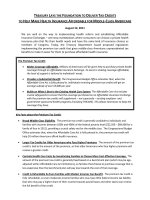EXPRESSING THOUGHTS AND FEELINGS EFFECTIVELY
Bạn đang xem bản rút gọn của tài liệu. Xem và tải ngay bản đầy đủ của tài liệu tại đây (36.73 KB, 4 trang )
EXPRESSING THOUGHTS AND FEELINGS EFFECTIVELY
The ability to deliver thoughts and feelings towards other
people effectively is an important aspect of communicate.
However, it seems that verbal expression of ideas and displays
of emotions do not come easy to many people.
Verbal expression of ideas involves putting ideas into words. In
most cases, you need to verbally communicate your train of
thoughts for you to be understood by your listeners. In the
articulation of your thoughts, many factors are considered to
convey the message effectively. These elements will be further
discussed in the course of this article.
Your thinking pattern and feelings are well-coordinated which
means that whatever you think always tend to manifest through
your emotions. Along with good articulation of ideas, proper
display of emotions is also needed.
Not everyone is gifted with the ability to effectively express
thoughts and feelings. You could have encountered people who
get tongue-tied when asked about their opinions, some are
comfortable with silence, and while others struggle to release
their inner emotions. This is actually considered a barrier in
communication, so it must be resolved within the person in
order to start building good people skills.
Communicate Clearly and Openly
Misunderstandings and misinterpretations are often rooted
from lack of clear and open communication. If you would rather
opt to stay silent instead of spitting out whatever you wish to
say to a person, do not be surprised if quarrels and constant
fights happen. You cannot expect the person to just read your
mind while you keep things to yourself. So, here are a few tips
on how to communicate clearly and openly:
Do not hesitate to open up and talk. You will never learn to
express your thoughts if you allow fear of talking or speaking to
overpower you.
Learn from the people around you who are confident and
comfortable enough in expressing what they think and feel.
Avoid being vague in your statements. If you wish to be
understood easily, use simple and direct statements.
Tell the person what you feel as of the moment. If the
conversation relies heavily on emotions, communicate as well
your feelings so that you will be better understood.
Channel Your Emotions Well
It is hard to fake emotions and let it contradict what the mind
perceives. For example, if you are thinking of a bad situation
such as the loss of something or someone, your emotions
follow suit. Heavy feelings dominate the emotions in relation to
the current state of mind.
For you to be able to properly express your feelings, manifest
what is genuinely felt. This way, the other person will know how
to deal with you and misinterpretations of feelings can be
avoided as well.
You must have heard of a displaced emotion such as displaced
anger. It simply means the kind of emotion that is not suitable
for the situation or the circumstance, which becomes the
reason why people refrain from talking to you. Always
remember to be true to what you feel and let it surface.
Be Direct and Straight to the Point
One problem with some individuals in expressing their thoughts
is indirectness in getting the message across. They tend to beat
around the bush and mention unnecessary details before
spilling out the main point. Doing so would make you ineffective
in delivering your thoughts and feelings. How do manage to cut
the chase and go straight to the bull’s eye?
Get the main idea of what you wish to convey. Express it first
and then support it with explanation. If there is a need to
reason out, go ahead and supply the reason for choosing your
point.
Convey the right tone for the conversation. This makes it easy to
express the meaning of what you are saying.
Keep it simple, but not overly simple. They say that the more
you talk, the more mistakes you get. However, simply giving a
one or two-liner statement will possibly leave your listener
hanging and leave the person confused about your intentions.
Make it a point to ask if your listener understood, to check
comprehension and active listening. Never assume that the
other party fully understands you.









